
Jacques-Émile Blanche (French: [blɑ̃ʃ]; 1 January 1861 – 30 September 1942) was a French artist, largely self-taught, who became a successful portrait painter, working in London and Paris.
Early life
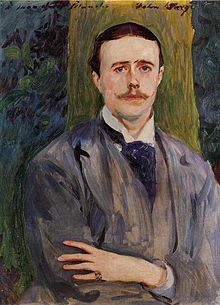
Blanche, an only child, was born in Paris in the 16eme. His father, whose name he shared, was a successful psychiatrist who ran a fashionable clinic on the heights of Montmartre, and he was brought up in the rich Parisian neighborhood of Passy in a house that had belonged to the Princesse de Lamballe. As he grew up, he encountered many remarkable artists. His father's drawing room was frequented by many of the Parisian celebrities in literature and the arts — including Jules Michelet, Charles Renouvier, Hector Berlioz, Camille Corot, Louis Français, and numerous others. At Dr. Blanche's house there were regular Saturday meetings devoted either to some artistic performance or to conversation about aesthetic or literary subjects. Some of Berlioz's Les Troyens was first sung by Anne Charton-Demeur for guests of Dr. Blanche.
Career
Although Blanche received some instruction in painting from Henri Gervex and Pierre-Auguste Renoir, he may be regarded as self-taught. He became a very successful portrait painter, with a style derived from 18th-century English painters such as Thomas Gainsborough as well as Édouard Manet and John Singer Sargent. He worked in London, where he spent time from 1870 on, as well as Paris, where he exhibited at the Salon and the Société Nationale des Beaux-Arts. One of his closest friends was Marcel Proust, who helped edit several of Blanche's publications. He also knew Henry James and is mentioned in Gertrude Stein's The Autobiography of Alice B. Toklas. In Paris, at the Académie Vitti, he took a portraiture class with Canada’s first female battlefield artist Mary Riter Hamilton.
In 1902, Jacques-Émile Blanche took over the direction of the Académie de La Palette, where he would remain director until 1911. He taught at the Académie Vitti in 1903.
Among the painter's most famous works are portraits of his father, Marcel Proust (private collection, Paris), the poet Pierre Louÿs, the Thaulow family (Musée d'Orsay, Paris), Aubrey Beardsley (National Portrait Gallery, London), and Yvette Guilbert and the infamous beauty Virginia Oldoini, Countess of Castiglione whom his father had treated for mental illness. Others he painted included James Joyce, Julia Stephen, Edgar Degas, Claude Debussy, Auguste Rodin, Colette, Thomas Hardy, John Singer Sargent, Charles Conder, Percy Grainger, and Tamara Karsavina as Stravinsky's Firebird.
Blanche purchased Les Grandes Baigneuses from his former teacher Pierre-Auguste Renoir, for 1,000 Francs. It was sold to Carroll Sargent Tyson, Jr. in 1927, and bequeathed to the Philadelphia Museum of Art in 1963.
Personal life
Blanche was well known in Parisian society to be homosexual, though closeted. After the Oscar Wilde trials he married Rose Lemoinne, daughter of John Lemoinne the journalist, publisher and editor of the influential Parisian newspaper Journal des Débats. But the marriage was never consummated. One of his lovers may have been the Spanish painter Rafael de Ochoa, whom Blanche wrote shared the "same tendencies", and features with him in a self-portrait. Blanche died at his home in Offranville-en-Caux, Normandy, France on 30 September 1942.
He was buried in the 2nd section of Passy Cemetery.
Posterity
A street in Offranville and a street in Dieppe were named after him.
In Offranville, there is a museum located on the 2nd floor of the Maison du Parc du Colombier which brings together paintings, complete literary works, souvenirs, letters and photographs of the artist, his family and his works.
Published works
He was the author of the unreliable Portraits of a Lifetime: the late Victorian era: the Edwardian pageant: 1870–1914 (London: J.M. Dent, 1937) and More Portraits of a Lifetime, 1918–1938 (London: J.M. Dent, 1939), about which Walter Sickert said "he is liable to twist things he hears or doesn't into monstrous fibs".
Selected paintings
-
 Self-Portrait with Raphael de Ochoa, 1890, Cleveland Museum of Art
Self-Portrait with Raphael de Ochoa, 1890, Cleveland Museum of Art
-
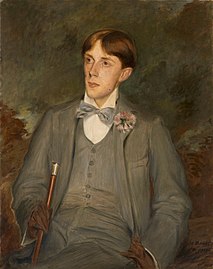 Aubrey Beardsley
Aubrey Beardsley
-
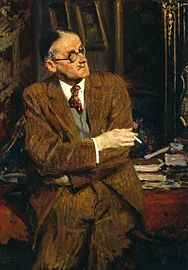 James Joyce
James Joyce
-
 Julia Stephen
Julia Stephen
-
 Marcel Proust at age 21
Marcel Proust at age 21
-
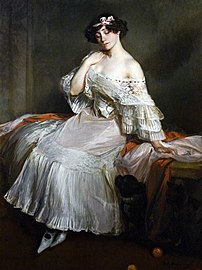 Portrait of Colette - Museu Nacional d'Art de Catalunya
Portrait of Colette - Museu Nacional d'Art de Catalunya
-
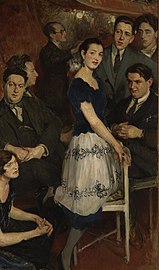 Les Six
Les Six
-
 Violet Trefusis
Violet Trefusis
References
- Lawton, Frederick (June 1, 1906). "Jacques Emile Blanche". The Fortnightly Review. 79 (474): 1106–1114.
- ^ Stevens, Thomas (2019). Pierre-Auguste Renoir. London, U.K.: Arcturus. p. 57. ISBN 978-1-78828-574-2.
The painting was bought for just 1,000 Francs by Jacques-Émile Blanche, a young artist who has once been a pupil of Renoir's.
- Chisholm, Hugh, ed. (1911). "Blanche, Jacques Émile" . Encyclopædia Britannica. Vol. 4 (11th ed.). Cambridge University Press. p. 40.
- Abdy, Jane. "Blanche, Jacques-Emile" in Oxford Art Online.
- Jacques-Émile Blanche, Maurice Denis, Correspondence, (1901-1939)
- Benezit Dictionary of Artists
- "Vitti, ??-??", The Correspondence of James McNeill Whistler, University of Glasgow, retrieved 2017-07-17
- Philadelphia Museum of Art. "Philadelphia Museum of Art - Collections Object : The Large Bathers".
- Georges-Paul Collet, Jacques-Émile Blanche: Biographie, Éds. Bartillat, Paris 2006, pp63-64, 484
- Jacques-Émile Blanche, La pêche aux souvenirs, Paris: Flammarion, 1949, p166.
- "JACQUES BLANCHE, A FRENCH PAINTER; His Portraits Included Many of the Republic's Social and Political Celebrities DIES IN NORMANDY AT 81 Son of Noted Neurologist Also Art Critic. -- Paris Street Named for Grandfather" (PDF). The New York Times. 6 October 1942. Retrieved 21 June 2019.
- Wendy Baron, Miss Ethel Sands and her circle (London: Peter Owen, 1977) p. 77.
- Julia Prinsep Stephen, née Jackson (1846–1895)
External links
- Works by or about Jacques-Émile Blanche at the Internet Archive
- 44 artworks by or after Jacques-Émile Blanche at the Art UK site
- Jacques Emile Blanche: The Biggest Anglophile of the French Painters
 Media related to Jacques-Émile Blanche at Wikimedia Commons
Media related to Jacques-Émile Blanche at Wikimedia Commons
- 1861 births
- 1942 deaths
- Painters from Paris
- 19th-century French painters
- 19th-century French male artists
- 20th-century French painters
- 20th-century French male artists
- French portrait painters
- 19th-century French engravers
- 20th-century French engravers
- 19th-century French male writers
- 20th-century French non-fiction writers
- French male painters
- Members of the Ligue de la patrie française
- French art educators